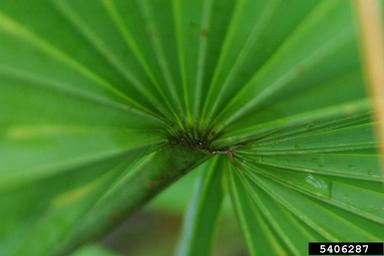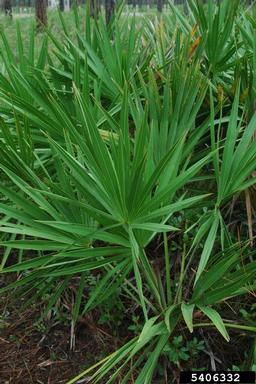
Adaptation
When a fire runs through an area where there is a lot of saw palmetto, the plants adapt quickly. They have quick responses to these circumstances. They can re-grow their leaves and flowers very quickly after a fire.
 These
plants have done a few things to adapt to their nutrient poor
environment. They have in their leaves a thick, almost
wholly cutinized epidermis. The leaf has stomata on both surfaces,
but can only be in intercostals regions. Also their leaf lamina's
are thick. These traits are what helps them to conserve water and use it effeciently.
These
plants have done a few things to adapt to their nutrient poor
environment. They have in their leaves a thick, almost
wholly cutinized epidermis. The leaf has stomata on both surfaces,
but can only be in intercostals regions. Also their leaf lamina's
are thick. These traits are what helps them to conserve water and use it effeciently.
Serenoa repens adapts to how much light it gets as well. If they have a lot of trees or plants above them they will not get much light.
Above Picture: Karan A. Rawlins, University of Georgia, Bugwood.org
Efficiency
When an organism lives in bad conditions, it needs to be
efficient in order to survive. One way that saw palmetto stays
efficient is by increasing the life span of their leaves. Saw
palmetto has leaves that often grow to be about three feet in
length. They have many leaves that are in an elongated shape. They do not get very wide, but as you
continue to read below you will find out that they live a long time
and this is what makes this organism efficient. It would not be smart for the
saw palmetto to shed its leaves all the time because that would cost
them valuable supplies. The plant would waste all the nutrients
that it had already put into the existing leaves. This would mean
the plant would have to put more of its valuable nutrients into new
leaves, which means spending a lot
of energy. So, Serenoa repens has adapted to expand the
life span of their leaves. When their leaf life span is at the
longest, they usually keep
them for around three and a half
years. If they do not have much above them blocking the sunlight,
then the leaf life span can be found to be less than two years.
palmetto to shed its leaves all the time because that would cost
them valuable supplies. The plant would waste all the nutrients
that it had already put into the existing leaves. This would mean
the plant would have to put more of its valuable nutrients into new
leaves, which means spending a lot
of energy. So, Serenoa repens has adapted to expand the
life span of their leaves. When their leaf life span is at the
longest, they usually keep
them for around three and a half
years. If they do not have much above them blocking the sunlight,
then the leaf life span can be found to be less than two years.
Clearly these organisms are very good at making do with what they have! Now that they have adapted to meet their environment, check out how they get some nutritious food!
Click Here to go back Home.
Above Picture: Karan A. Rawlins, University of Georgia, Bugwood.org